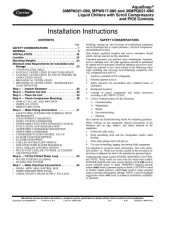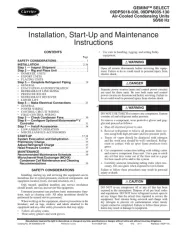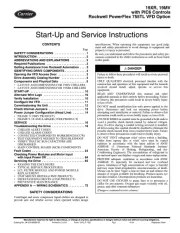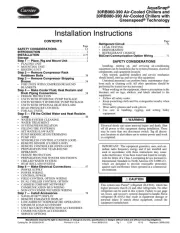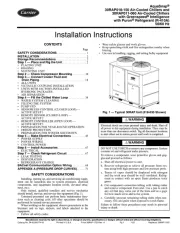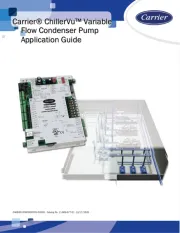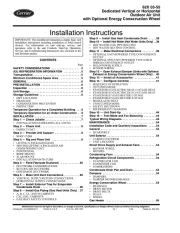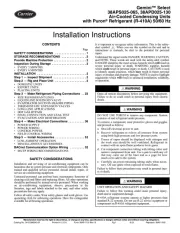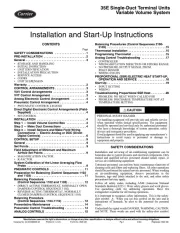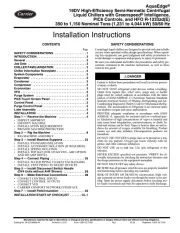
Manufacturer reserves the right to discontinue, or change at any time, specifications or designs without notice and without incurring obligations.
Catalog No. 04-53380043-01 Printed in U.S.A. Form 38AP-11SI Rev. B Pg 1 9-23 Replaces: 38AP-10SI
Installation Instructions
CONTENTS
Page
SAFETY CONSIDERATIONS . . . . . . . . . . . . . . . . . . . 1
STORAGE RECOMMENDATIONS . . . . . . . . . . . . . . . 2
Provide Machine Protection . . . . . . . . . . . . . . . . . . . . 2
Inspection During Storage . . . . . . . . . . . . . . . . . . . . . 2
• EVERY 3 MONTHS
• EVERY 6 MONTHS
INSTALLATION . . . . . . . . . . . . . . . . . . . . . . . . . . . . . . 2
Step 1 — Inspect Shipment . . . . . . . . . . . . . . . . . . . . 2
Step 2 — Rig and Place Unit . . . . . . . . . . . . . . . . . . . 2
• DOMESTIC UNITS
• EXPORT UNITS
•PLACING UNITS
Step 3 — Make Refrigerant Piping Connections . . 23
• SIZE REFRIGERANT LINES
• LIQUID LINE SOLENOID VALVE
• EVAPORATOR SUCTION HEADER PIPING
• THERMOSTATIC EXPANSION VALVES
• LONG LINE APPLICATIONS
• HOT GAS BYPASS
• FINAL CONNECTION AND LEAK TEST
• EVACUATION AND DEHYDRATION
Step 4 — Make Electrical Connections . . . . . . . . . . 36
• POWER SUPPLY
•POWER WIRING
• CONTROL POWER
• FIELD CONTROL WIRING
Step 5 — Install Accessories . . . . . . . . . . . . . . . . . . 52
• LOW-AMBIENT OPERATION
• MISCELLANEOUS ACCESSORIES
BACnet Communication Option Wiring . . . . . . . . . 52
• MS/TP WIRING RECOMMENDATIONS
SAFETY CONSIDERATIONS
Installation and servicing of air-conditioning equipment can be
hazardous due to system pressure and electrical components. Only
trained and qualified service personnel should install, repair, or
service air-conditioning equipment.
Untrained personnel can perform basic maintenance functions of
cleaning coils and filters and replacing filters. All other operations
should be performed by trained service personnel. When working
on air-conditioning equipment, observe precautions in the
literature, tags and labels attached to the unit, and other safety
precautions that may apply.
Follow all safety codes. Wear safety glasses and work gloves. Use
quenching cloth for unbrazing operations. Have fire extinguisher
available for all brazing operations.
It is important to recognize safety information. This is the safety-
alert symbol . When you see this symbol on the unit and in
instructions or manuals, be alert to the potential for personal
injury.
Understand the signal words DANGER, WARNING, CAUTION,
and NOTE. These words are used with the safety-alert symbol.
DANGER identifies the most serious hazards which will result in
severe personal injury or death. WARNING signifies hazards
which could result in personal injury or death. CAUTION is used
to identify unsafe practices, which may result in minor personal
injury or product and property damage. NOTE is used to highlight
suggestions which will result in enhanced installation, reliability,
or operation.
WARNING
Open all remote disconnects before servicing this equipment.
Failure to do so could result in personal injury from electric
shock.
WARNING
DO NOT USE TORCH to remove any component. System
contains oil and refrigerant under pressure.
To remove a component, wear protective gloves and goggles
and proceed as follows:
a. Shut off electrical power to unit.
b. Recover refrigerant to relieve all pressure from system
using both high-pressure and low pressure ports.
c. Traces of vapor should be displaced with nitrogen and
the work area should be well ventilated. Refrigerant in
contact with an open flame produces toxic gases.
d. Cut component connection tubing with tubing cutter and
remove component from unit. Use a pan to catch any oil
that may come out of the lines and as a gage for how
much oil to add to the system.
e. Carefully un-sweat remaining tubing stubs when neces-
sary. Oil can ignite when exposed to torch flame.
Failure to follow these procedures may result in personal inju-
ry or death.
WARNING
UNIT OPERATION AND SAFETY HAZARD
Failure to follow this warning could cause personal injury,
death and/or equipment damage.
R-410A refrigerant systems operate at higher pressures than
standard R-22 systems. Do not use R-22 service equipment or
components on R-410A refrigerant equipment.
Gemini™ Select
38APS025-065, 38APD025-130
Air-Cooled Condensing Units
with Puron
®
Refrigerant (R-410A) 50/60 Hz

